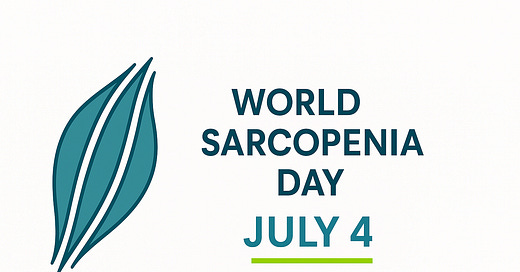Marjorie is 67, still juggling part-time work and grand-kid duty. Last month she whispered, “Groceries take two trips now.” Routine labs looked fine. There had been no illness or injury. The real issue, never mentioned by her prior clinicians, was sarcopenia: age-related loss of muscle mass and strength. Up to 50 % of adults ≥ 80 live with clinically low muscle.
What Exactly Is Sarcopenia?
Sarcopenia is a clinical syndrome of low muscle strength confirmed by low muscle mass. The 2024 Global Leadership Initiative on Sarcopenia (GLIS) consensus, sets grip-strength cut-offs (< 27 kg men; < 16 kg women) and appendicular lean-mass indices. Poor gait speed is now an outcome, not a definition. Translation: weak + undersized muscle = sarcopenia.
Why It Matters
Low muscle isn’t cosmetic. It raises fall and fracture risk, increases hospital length-of-stay, predicts slower recovery, and carries higher mortality. Muscle is a metabolic organ: more muscle means better glucose control and immune reserve.
How Did We Get Here?
After 30 we lose 3–8 % of muscle per decade; the slope steepens after 60. Drivers include anabolic resistance, inactivity, chronic inflammation, and some drugs (e.g., glucocorticoids). Yet fewer than 10 % of primary-care visits measure any strength. Result: sarcopenia remains invisible until a fall or fracture pulls the alarm.
First-Line Solution: PAS
Problem We under-diagnose a condition that silently erodes independence.
Agitation Once weakness is obvious, fall risk may have doubled.
Solution Two levers in this order:
Progressive resistance training ≥ 2 sessions/week. Fiatarone’s landmark trial showed 90-year-olds tripled leg strength in 8 weeks.
Protein 1.2–1.6 g·kg⁻¹·day⁻¹ (~0.4 g·kg⁻¹ per meal) to fuel adaptation and overcome anabolic resistance.
We’ll unpack each lever this week: Tuesday’s Exercise Blueprint (progressive 4-week plan) followed by Wednesday’s Nutrition Playbook (7-day ~120 g protein menu).
Your 7-Day Road Map
Sat 28 Jun: Definition & scope
Sun 29 Jun: Who’s at Risk?
Mon 30 Jun: Why It Matters
Tue 01 Jul: Exercise Blueprint
Wed 02 Jul: Nutrition Playbook
Thu 03 Jul: Myth-Busting + Hope
Fri 04 Jul: World Sarcopenia Day Guide
Subscribe now to unlock your 7-day muscle-strength roadmap and take control of your independence as you age.
Recommended Reading
Cruz-Jentoft AJ, Bahat G, Bauer J, et al. Sarcopenia: revised European consensus on definition and diagnosis. Age Ageing. 2019;48(1):16–31. doi:10.1093/ageing/afy169. Erratum in: Age Ageing. 2019;48(4):601. doi:10.1093/ageing/afz046. PMID:30312372; PMCID:PMC6322506.
Kirk B, Cawthon PM, Arai H, et al. The conceptual definition of sarcopenia: Delphi consensus from the Global Leadership Initiative in Sarcopenia (GLIS). Age Ageing. 2024;53(3):afae052. doi:10.1093/ageing/afae052. PMID:38520141; PMCID:PMC10960072.
Mitchell WK, Williams J, Atherton P, Larvin M, Lund JN, Narici M. Sarcopenia, dynapenia, and the impact of advancing age on human skeletal muscle size and strength: a quantitative review. Front Physiol. 2012;3:260. doi:10.3389/fphys.2012.00260. PMID:22934016; PMCID:PMC3429036.
Fiatarone MA, Marks EC, Ryan ND, Meredith CN, Lipsitz LA, Evans WJ. High-intensity strength training in nonagenarians: effects on skeletal muscle. JAMA. 1990;263(22):3029–3034. PMID:2342214.





Looking forward to your information on sarcopenia.